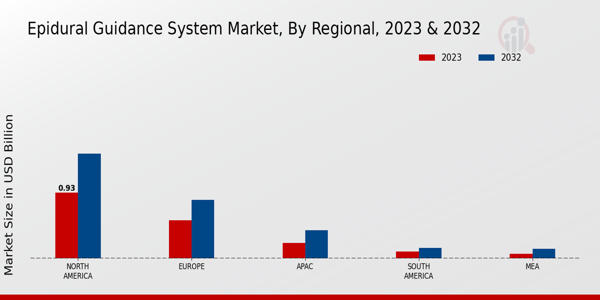Market Growth Projections
The Global Epidural Guidance System Market Industry is poised for substantial growth, with projections indicating a market value of 2.07 USD Billion in 2024 and an anticipated increase to 3.71 USD Billion by 2035. This growth trajectory reflects a compound annual growth rate (CAGR) of 5.46% from 2025 to 2035. The expansion of the market is driven by various factors, including technological advancements, increasing prevalence of chronic pain disorders, and growing acceptance of epidural anesthesia. These dynamics suggest a robust future for the industry, as healthcare providers continue to seek innovative solutions for effective pain management.
Regulatory Support and Reimbursement Policies
Regulatory support and favorable reimbursement policies play a crucial role in shaping the Global Epidural Guidance System Market Industry. Governments and health organizations are increasingly recognizing the importance of effective pain management solutions, leading to the establishment of supportive regulatory frameworks. Additionally, reimbursement policies that cover the costs associated with epidural guidance systems encourage healthcare providers to adopt these technologies. As a result, the market is likely to benefit from enhanced accessibility and affordability of epidural procedures. This supportive environment is expected to drive growth, as more facilities integrate epidural guidance systems into their pain management protocols.
Increasing Prevalence of Chronic Pain Disorders
The Global Epidural Guidance System Market Industry is significantly impacted by the increasing prevalence of chronic pain disorders. Conditions such as lower back pain and neuropathic pain are becoming more common, leading to a higher demand for effective pain management solutions. Epidural injections, facilitated by guidance systems, are widely recognized for their efficacy in alleviating chronic pain. As the global population ages and the incidence of chronic pain rises, the market is projected to grow at a CAGR of 5.46% from 2025 to 2035. This trend underscores the importance of epidural guidance systems in addressing the growing burden of chronic pain, thereby driving market expansion.
Rising Demand for Minimally Invasive Procedures
The Global Epidural Guidance System Market Industry experiences a notable increase in demand for minimally invasive procedures. As healthcare providers aim to reduce patient recovery times and minimize surgical risks, epidural guidance systems become essential tools in pain management and anesthesia. The market is projected to reach 2.07 USD Billion in 2024, reflecting a growing preference for these advanced technologies. This trend is particularly evident in regions with high surgical volumes, where the adoption of epidural guidance systems enhances procedural accuracy and patient outcomes. Consequently, the industry is likely to see a sustained growth trajectory as more healthcare facilities integrate these systems into their practices.
Technological Advancements in Imaging Techniques
Technological advancements in imaging techniques significantly influence the Global Epidural Guidance System Market Industry. Innovations such as ultrasound and fluoroscopy improve the precision of epidural injections, leading to better patient outcomes. These advancements not only enhance the accuracy of needle placement but also reduce the incidence of complications associated with epidural anesthesia. As healthcare providers increasingly adopt these technologies, the market is expected to expand, with projections indicating a growth to 3.71 USD Billion by 2035. This growth is driven by the need for improved patient safety and the effectiveness of pain management strategies, positioning advanced imaging techniques as a critical driver in the industry.
Growing Awareness and Acceptance of Epidural Anesthesia
Growing awareness and acceptance of epidural anesthesia contribute to the expansion of the Global Epidural Guidance System Market Industry. As patients become more informed about the benefits of epidural anesthesia for pain relief during labor and surgical procedures, healthcare providers are witnessing an increase in requests for these services. This shift in patient preference encourages hospitals and clinics to invest in advanced epidural guidance systems, enhancing their service offerings. The market's growth is further supported by educational initiatives aimed at both healthcare professionals and patients, fostering a more favorable environment for the adoption of epidural anesthesia. This trend is likely to sustain the industry's upward trajectory.




















